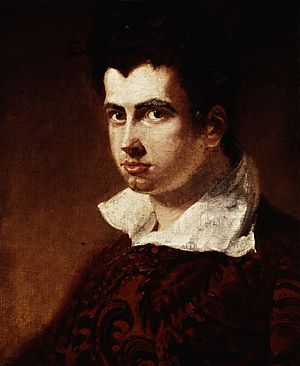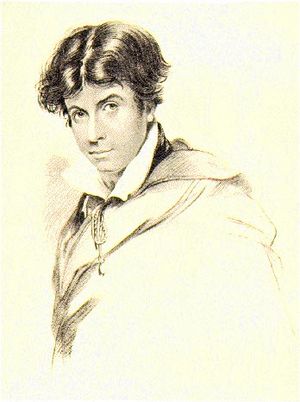Leigh Hunt facts for kids
Quick facts for kids
Leigh Hunt
|
|
|---|---|

Leigh Hunt; portrait by Benjamin Haydon
|
|
| Born |
James Henry Leigh Hunt
19 October 1784 |
| Died | 28 August 1859 (aged 74) Putney, London, England
|
| Burial place | Kensal Green Cemetery |
| Education | Christ's Hospital, Newgate Street, London |
| Spouse(s) |
Marianne Kent
(m. 1808; died 1857) |
| Children | 10, including Thornton Leigh Hunt |
| Relatives |
|
James Henry Leigh Hunt (born October 19, 1784 – died August 28, 1859) was an English writer. He was known as a critic, essayist, and poet.
Leigh Hunt helped start The Examiner. This was an important newspaper that shared new ideas. He was also a key person in a group of writers in Hampstead. This group included famous writers like William Hazlitt and Charles Lamb. Hunt also helped introduce poets like John Keats and Percy Bysshe Shelley to the public.
Hunt was at Shelley's funeral in Italy. This moment was captured in a famous painting. He also inspired a character in Charles Dickens' novel Bleak House.
Contents
Early Life and Education
James Henry Leigh Hunt was born on October 19, 1784. His parents had moved to Southgate, London from the United States. They had to leave America because they supported Britain during the American War of Independence.
His father, Isaac, was a lawyer. His mother, Mary, was a Quaker. In England, Isaac became a popular speaker. He also taught the nephew of a duke. Leigh Hunt was named after this nephew.
Leigh Hunt went to Christ's Hospital in London from 1791 to 1799. He wrote about his time there in his autobiography. He loved reading and writing poems. He admired poets like Thomas Gray.
Hunt had a speech problem when he was young. This stopped him from going to university. He spent his time visiting friends and writing poems. His first poems were published in 1801. This helped him meet other writers and actors. He also wrote for newspapers and published books about theater.
Family Life
In 1809, Leigh Hunt married Marianne Kent. They had ten children together over 20 years. Some of their children were Thornton Leigh, John Horatio, and Mary Florimel.
Marianne was often sick. She passed away in 1857. Leigh Hunt did not write much about his family in his autobiography. Marianne's sister, Elizabeth Kent, helped him with his writing.
Starting Newspapers
The Examiner Newspaper
In 1808, Hunt became the editor of The Examiner. His brother, John Hunt, started this newspaper. It became known for its independent political views. It would criticize anyone it felt deserved it.
In 1813, The Examiner criticized Prince Regent George. It described him as "corpulent" (meaning overweight). Because of this, the British government put Leigh Hunt and his brothers in jail for two years. Leigh Hunt was held at the Surrey County Gaol.
Many famous people visited Leigh Hunt in jail. These included Lord Byron and Charles Lamb. Hunt handled his time in jail very well. He even decorated his cell to make it feel like a fairy tale.
Other Publications
Hunt also edited other magazines. From 1810 to 1812, he edited The Reflector. He wrote a funny poem for it called "The Feast of the Poets". This poem made some other poets upset.
Later, he edited The Indicator (1819–1821). This weekly magazine had reviews, essays, and poems. He also edited The Companion in 1828.
His Poetry
In 1816, Hunt published a long poem called Story of Rimini. It was based on a sad story from Dante's Inferno. Hunt liked the style of older poets like Geoffrey Chaucer.
Hunt's writing style was sometimes lighthearted. This sometimes led to others making fun of his work. In 1818, he published a collection of poems called Foliage.
Hunt was part of a group of writers in Hampstead. This group included John Keats and Percy Bysshe Shelley. They were sometimes called the "Cockney School" by critics. Some of Hunt's most famous poems are "Jenny kiss'd Me" and "Abou Ben Adhem".
Friends and Travels
Leigh Hunt was very close friends with Keats and Shelley. Shelley even helped Hunt with money when he was struggling. In return, Hunt supported Shelley and defended him in his newspaper.
After Shelley moved to Italy in 1818, Hunt faced more money problems. His health and his wife's health also got worse. He had to stop publishing The Indicator.
Shelley suggested that Hunt join him and Lord Byron in Italy. They wanted to start a new magazine there. This magazine would allow them to share liberal ideas freely. Hunt arrived in Italy in July 1822. Sadly, Shelley died just one week later.
Hunt then depended on Byron for support. But Byron was not very interested in helping him. The new magazine, The Liberal, only lasted for four issues. It included important works by Byron and Shelley. In 1823, Byron left Italy. Hunt stayed in Genoa until 1825. He enjoyed the Italian weather and culture.
Later Years
In 1825, Hunt returned to England because of a legal issue. In 1828, he published a book about Lord Byron. Some people were upset by this book. They felt Hunt was being unfair to Byron, who had helped him.
Hunt continued to struggle with money and health problems. He kept working hard, but many of his new projects failed. He edited The Tatler (1830–1832) and London Journal (1834–1835).
In 1832, he published a collection of his poems. Many people, even those who disagreed with him, bought copies. He also became friends with the writer Thomas Carlyle.
Hunt wrote a successful novel called Sir Ralph Esher. In 1835, he published Captain Sword and Captain Pen. This poem compared the good things that come from peace to the harm caused by war.
In 1840, Hunt's play Legend of Florence was performed. This helped him financially. He also wrote introductions for works by famous playwrights.
In his final years, Hunt received financial help. In 1844, Mary Shelley gave him money each year. In 1847, Lord John Russell gave him a pension.
With better finances, Hunt published more books. These included Imagination and Fancy (1844) and Wit and Humour (1846). These books showed his good taste in poetry. He also wrote about the history of Kensington in The Old Court Suburb (1855).
In 1850, Hunt published his Autobiography. This book gave an honest look at his life. He died in Putney, London, on August 28, 1859. He was buried at Kensal Green Cemetery.
Inspired by Leigh Hunt
Charles Dickens said that Leigh Hunt inspired the character Harold Skimpole in his novel Bleak House. Dickens wrote that Skimpole was a very accurate picture of a real person. Another critic agreed, saying everyone who knew Leigh Hunt recognized the character.
Other Works
- Amyntas, A Tale of the Woods (1820), a translation of Tasso's Aminta
- The Seer, or Common-Places refreshed (1840–1841)
- Stories from the Italian Poets (1846)
- One Hundred Romances of Real Life (1843)
His collected poems were published in 1857. His son, Thornton Leigh Hunt, published more of his works and letters after his death.


